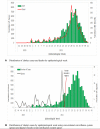Epidemiology, diagnostics and factors associated with mortality during a cholera epidemic in Nigeria, October 2020-October 2021: a retrospective analysis of national surveillance data
- PMID: 36123095
- PMCID: PMC9486350
- DOI: 10.1136/bmjopen-2022-063703
Epidemiology, diagnostics and factors associated with mortality during a cholera epidemic in Nigeria, October 2020-October 2021: a retrospective analysis of national surveillance data
Abstract
Objectives: Nigeria reported an upsurge in cholera cases in October 2020, which then transitioned into a large, disseminated epidemic for most of 2021. This study aimed to describe the epidemiology, diagnostic performance of rapid diagnostic test (RDT) kits and the factors associated with mortality during the epidemic.
Design: A retrospective analysis of national surveillance data.
Setting: 33 of 37 states (including the Federal Capital Territory) in Nigeria.
Participants: Persons who met cholera case definition (a person of any age with acute watery diarrhoea, with or without vomiting) between October 2020 and October 2021 within the Nigeria Centre for Disease Control surveillance data.
Outcome measures: Attack rate (AR; per 100 000 persons), case fatality rate (CFR; %) and accuracy of RDT performance compared with culture using area under the receiver operating characteristic curve (AUROC). Additionally, individual factors associated with cholera deaths and hospitalisation were presented as adjusted OR with 95% CIs.
Results: Overall, 93 598 cholera cases and 3298 deaths (CFR: 3.5%) were reported across 33 of 37 states in Nigeria within the study period. The proportions of cholera cases were higher in men aged 5-14 years and women aged 25-44 years. The overall AR was 46.5 per 100 000 persons. The North-West region recorded the highest AR with 102 per 100 000. Older age, male gender, residency in the North-Central region and severe dehydration significantly increased the odds of cholera deaths. The cholera RDT had excellent diagnostic accuracy (AUROC=0.91; 95% CI 0.87 to 0.96).
Conclusions: Cholera remains a serious public health threat in Nigeria with a high mortality rate. Thus, we recommend making RDT kits more widely accessible for improved surveillance and prompt case management across the country.
Keywords: Diagnostic microbiology; EPIDEMIOLOGY; Public health.
© Author(s) (or their employer(s)) 2022. Re-use permitted under CC BY-NC. No commercial re-use. See rights and permissions. Published by BMJ.
Conflict of interest statement
Competing interests: None declared.
Figures




References
-
- World Health Organization . Cholera Wkly Epidemiol Rec; 2020: 445–54. https://apps.who.int/iris/bitstream/handle/10665/345271/WER9637-445-454-...
-
- World Health Organization . Weekly epidemiological record cholera Cholera; 2019. https://apps.who.int/iris/bitstream/handle/10665/334242/WER9537-441-448-...
-
- Cholera Platform . Cholera Outbreaks in Central and West Africa : 2020 Regional Update-Week 1-53, 2020. Available: www.plateformecholera.info
-
- World Health Organization Africa . Weekly Bulletin on Outbreaks and other Emergencies, Week 27: 29 June - 5 July 2020; 2020. https://apps.who.int/iris/bitstream/handle/10665/332993/OEW27-2905050720...
MeSH terms
Substances
Grants and funding
LinkOut - more resources
Full Text Sources
Medical
Research Materials
Miscellaneous
